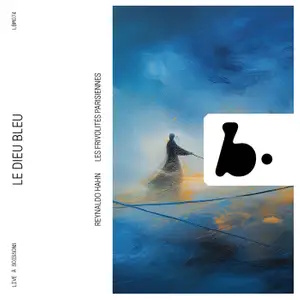
Reynaldo Hahn (1874-1947)
Le Dieu Bleu, ballet in one Act (1912)
Orchestre Les Frivolités Parisiennes/Dylan Corlay
rec. live, 21 September, 2023; Théâtre du Châtelet, Paris
B Records LBM074 [46]
This CD is an interesting enterprise from the B records company. Reynaldo Hahn’s score for the ballet Le Dieu Bleu has not seen the light of day since its initial performances with the Sergei Diaghilev’s Ballets Russes in 1912. For decades Le Dieu Bleu has only existed as a series of lovely set and costume designs by Léon Bakst and a series of intriguing photographs of Vaslav Nijinsky in the title role. The ballet was initially presented on a double bill with Balakirev’s Thamar (a musical adaptation of his symphonic poem Tamara). They were choreographed by the legendary Mikhail Fokine and featured star dancers Tamara Karsavina and Nijinski. Both ballets should have been sure-fire hits; however, the 1912 Ballets Russes program was a musically exciting season which Paris saw the world premieres of Nijinsky’s Ballet L’Après-midi d’un faune (which he adapted from Debussy’s orchestral prelude), Dukas’ La Péri and Ravel’s Daphnis et Chloé, the Hahn and Balakirev ballets didn’t seem to measure up to the standard of the magnificent works which preceded them. At the time everyone involved received fairly negative critical response, even Nijinsky’s dancing was not immune from the bad press. Only the set and costume designs received universal praise. This recording then is the first time that Hahn’s ballet has been heard since 1912; how fitting that it was recorded in the same theatre that saw its opening night. The ballet’s plot concerns a blue deity who arises from a pool of water to save a young Indian maiden in distress. A more detailed synopsis can be found on Wikipedia.
Hahn is an interesting composer who is responsible for some of the most beautiful pieces in the repertoire of French songs for voice and piano. He is also very good at concocting light music for the stage in the examples of Ciboulette (review) and Ô mon bel inconnu (review). The stuff of dramatic ballet does not seem to have been his forte. This comes as a surprise when one considers the relatively dramatic life that Hahn led with Marcel Proust. His score for Le Dieu Bleu is dramatically rather limp, although it does have a lovely orchestration and has some pleasing effects throughout.
The Première danse is rather expansive in its mood and reminds one of similar music that Erik Satie used in his later ballet Parade. Here conductor Dylan Corlay gives the orchestral motifs full sway and highlights the graceful orchestration. Corlay is also very good at bringing out the slightly eerie sound-world in the Dance of the Yoghis.
During the section Monstres et démons Hahn indulges in some delightful effects for the percussion section which emulate the sound-world of a gamelan ensemble. Benjamin Britten did much the same thing in his ballet The Prince of the Pagodas and later in the dance portions of Death in Venice. Le Dieu Bleu gives evidence that Britten wasn’t the first composer to have a similar inspiration.
I feel that there are times when Dylan Corlay and Les Frivolités Parisiennes sound a little too comfortable with the music; certainly they could push a little harder than they do in Colère des prêtres which could use a good deal more Colère than I sense here. I am willing to admit that the fault there really lies with the composer.
This is an interesting recording and certainly it is welcome to at last have a chance to hear the long neglected score. However, there are two complaints I must make about this CD release. The booklet notes, while extensive, are woefully inadequate. They consist of a long interview with the conductor about the recording project. There is no description of the action, or indeed the history and circumstances of the ballet. One has to go to the internet to find out anything at all about the work. The other less serious charge is that at 47 minutes this CD is less than generous. There is enough room available to include either Balakirev’s Tamara tone poem or at least some excerpts from the ballet which eventually was derived from Balakirev’s score. For those who are curious there are a couple of fine performances of the ballet Thamar which can be viewed on YouTube showing full stagings of the entire work. The Balakirev ballet doesn’t seem to have disappeared quite as completely as Le Dieu Bleu.
Mike Parr
Buying this recording via a link below generates revenue for MWI, which helps the site remain free




















